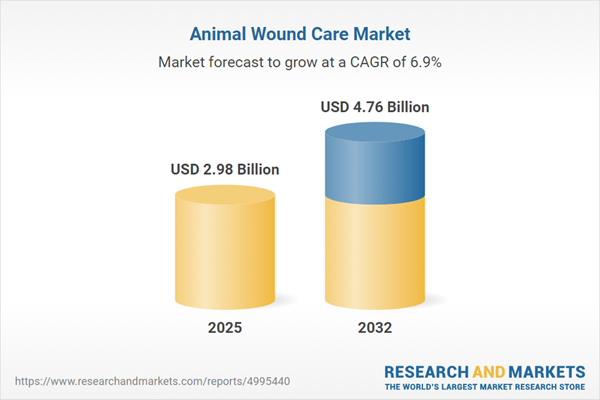Speak directly to the analyst to clarify any post sales queries you may have.
The animal wound care market is experiencing rapid transformation as veterinary practices seek next-generation solutions to address increasingly complex wound management challenges. Innovative products, regulatory shifts, and digitization are defining new standards in this evolving industry, prompting strategic adaptation across the value chain.
Market Snapshot: Animal Wound Care Market Size and Growth
The Animal Wound Care Market grew from USD 2.79 billion in 2024 to USD 2.98 billion in 2025. It is expected to continue growing at a CAGR of 6.88%, reaching USD 4.76 billion by 2032.
Scope & Segmentation
This comprehensive report analyzes global trends, innovations, and competitive activity within the animal wound care industry, focusing on key segments and regional variations:
- Product Type: Ancillary Products (antiseptics, wound cleansers), Bandages & Dressings (advanced and traditional), Surgical Instruments (forceps, retractors, scalpels, scissors), Suture Devices (absorbable, non-absorbable), Tissue Engineering Products (scaffolds, skin substitutes), and Topical Agents (analgesics, antimicrobials, growth factors).
- Animal Type: Companion Animals (cats, dogs), Equine, Livestock (cattle, pigs, sheep), Poultry (chickens, turkeys).
- Wound Type: Burns (chemical, thermal), Chronic Wounds (non-healing ulcers, pressure ulcers), Surgical Wounds (elective, emergency), Traumatic Wounds (abrasions, avulsions, lacerations).
- Distribution Channel: Offline (retail pharmacies, wholesalers, distributors) and Online purchases.
- Regions Covered: Americas (North America, Latin America), Europe, Middle East, Africa, Asia-Pacific (China, India, Japan, Australia, South Korea, Indonesia, Thailand, Malaysia, Singapore, Taiwan).
- Leading Companies: Advancis Veterinary Ltd, B Braun Melsungen AG, Essity AB, Johnson & Johnson Services, Inc., Jazz Medical LLC, Jorgensen Laboratories Inc., Jørgen Kruuse A/S, Medtronic PLC, Milliken & Company, SilverGlide Pty Ltd, Smith & Nephew PLC, Vernacare Ltd., Virbac S.A., Elanco Animal Health, Innovacyn Inc., Neogen Corporation.
Technology and Innovation Focus
- Advanced Biomaterials: Use of nanofiber scaffolds and tissue engineering for precise wound care.
- Digital Wound Assessment: Integration of imaging platforms and telemedicine for remote support and healing analytics.
- Regenerative Therapies: Tailored products for different species and wound types are elevating clinical outcomes.
- Green Manufacturing: Emergence of environmentally conscious production techniques and sustainable procurement.
Key Takeaways for Decision-Makers
- Adoption of smart dressing technologies and bioactive materials is significantly improving wound healing quality and consistency across veterinary clinics.
- Digital transformation in wound assessment and telemedicine enhances data-driven decisions, supports remote consultations, and helps standardize treatment protocols.
- Regulatory changes and evolving compliance frameworks require ongoing adaptation by manufacturers and suppliers to maintain market access and safeguard care standards.
- Targeted segmentation by animal class and wound type is essential for aligning product design, marketing initiatives, and distribution strategies with diverse clinical needs.
- Sustainability measures and green chemistry are influencing procurement preferences, adding value beyond clinical efficacy and supporting long-term market positioning.
- Strong collaborative networks, including partnerships with research institutions and cross-disciplinary alliances, are accelerating the commercialization of innovative wound care solutions.
Tariff Impact: United States Market Dynamics
Recent changes in U.S. tariff structures have recalibrated sourcing and pricing within the animal wound care sector. Distributors and manufacturers are reevaluating supply chains, expanding domestic production and establishing operations in free trade zones to offset higher import duties. These strategies are proving critical in stabilizing costs, ensuring continuous supply, and adapting to ongoing regulatory changes. Flexibility and proactive planning are emerging as priorities, enabling veterinary service providers to maintain quality while managing budgets.
Methodology & Data Sources
This report leverages primary interviews with veterinary specialists, product developers, and procurement officers, combined with extensive analysis of peer-reviewed literature, regulatory filings, and market data. Quantitative trends are cross-validated using patent databases, clinical trial listings, and adjacent market benchmarks. Robust triangulation and thematic synthesis methods ensure actionable and accurate insights for all stakeholders.
Why This Report Matters
- Enables senior leaders to identify the most promising innovations and optimize their product portfolios in line with evolving clinical and regulatory landscapes.
- Provides a comprehensive understanding of market shifts, risks, and opportunities—supporting confident investment, partnership, and procurement decisions.
- Equips organizations with competitive intelligence for sustainable growth in a sector shaped by rapid technological advancement and complex regional demands.
Conclusion
This analysis serves as a strategic guide for those seeking to navigate the complexities of animal wound care. By synthesizing macro trends, technology shifts, and regional factors, it offers a clear path to informed decision-making and sustainable market leadership.
Additional Product Information:
- Purchase of this report includes 1 year online access with quarterly updates.
- This report can be updated on request. Please contact our Customer Experience team using the Ask a Question widget on our website.
Table of Contents
3. Executive Summary
4. Market Overview
7. Cumulative Impact of Artificial Intelligence 2025
List of Figures
Samples

LOADING...
Companies Mentioned
The key companies profiled in this Animal Wound Care market report include:- Advancis Veterinary Ltd
- B Braun Melsungen AG
- Essity AB
- Johnson & Johnson Services, Inc.
- Jazz Medical, LLC
- Jorgensen Laboratories, Inc.
- Jørgen Kruuse A/S
- Medtronic PLC
- Milliken & Company
- SilverGlide Pty Ltd
- Smith & Nephew PLC
- Vernacare Ltd.
- Virbac S.A.
- Elanco Animal Health
- Innovacyn, Inc.
- Neogen Corporation.
Table Information
| Report Attribute | Details |
|---|---|
| No. of Pages | 183 |
| Published | October 2025 |
| Forecast Period | 2025 - 2032 |
| Estimated Market Value ( USD | $ 2.98 Billion |
| Forecasted Market Value ( USD | $ 4.76 Billion |
| Compound Annual Growth Rate | 6.8% |
| Regions Covered | Global |
| No. of Companies Mentioned | 17 |









